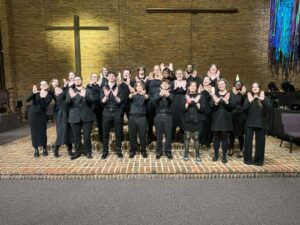Sarajevo University Professor Asikm Mujkić, a friend of Sociology Professor Keith Doubt, gave two speaking engagements at Wittenberg. Topics included Genocide in Bosnia, the Dayton Peace Accords and a bit about life today in the country of Bosnia-Herzegovina.
In 1995 representatives from the former states of Yugoslavia came to Dayton with the hopes of a U.S. brokered peace deal to end a war. This was mostly a success, but not until after over 102,000 people died and the Bosniak population had been targeted for genocide.
A shift in borders arrived with the break up of the USSR—which Yugoslavia was not part of, but received critical financial support from. This resulted in six states including Bosnia-Herzegovina. This was possibly Europe’s most complicated shift in geography and ethnicities were not fully considered.
Genocides require planning. Serbian military and civil authorities from Serbia and Bosnia-Herzegovina murdered more than 7,000 Bosniak males. Bosniaks are European Muslims. Bodies were dumped in mass graves. Thousands of women and children were forcefully relocated. Over 12,000 women were raped and some were held in “rape camps”. This genocide has been named the Srebrenica Massacre.
In the Q&A Professor Mujkić commented on his rock-n-roll band performing for persons of various ethnicities at events all over Bosnia—and hopefully the world soon. Ethnicity is irrelevant. The peace protests in the U.S. of the 1960’s and 1970’s also had no ethnicity boundaries and a solid foundation in rock-n-roll.
Professor Mujkić was asked: “Do Bosniaks currently have a mistrust of the UN or other outside bureaucratic agencies…” Answer: Absolutely. The 193 member United Nations with a multi billion dollar budget and “peacekeeping” forces were in Bosnia in 1995 to protect the Bosniaks. They even asked them to disarm, which they did. They experienced genocide. The UN was in Rwanda to protect the Tutsi’s from the Hutu’s in 1994. They experienced genocide. The UN was again sent to protect, this time in Sudan’s Darfur, in 2004. They experienced genocide. There hasn’t been a less effective form of protection since the days of “duck and cover.”
Rwanda outlawed the practice of stamping “HUTU” or “TUTSI” on their ID’s. No Hutu, no Tutsi, no ethnicities just Rwandan’s. This branding was as simple as the star of David used in Germany which assisted with the genocide of millions.
The worst in people can bring out the best in others. In Bosnia some only saw a different ethnicity while others only saw human beings. Hiding others, whom they often didn’t even know and risking death if caught, is also a trait of genocide. Actions of this kind continues to this day in Syria and Ukraine. Rarely do these stories make it in their entirety to the mainstream news, which feeds social media a highly filtered dissolution of their remains; these stories are often reduced to one line stories and a picture.
No more ethnicity brandings or lack of due process. Lets look at the original sources of news (in their entirety) and do so while listening to rock-n-roll.







